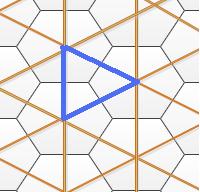Terrain Types - Natural and Hex
For war games, terrain is defined as an element of the board which affects movement and combat. Usually terrain resembles a real-life counterpart: Woods, Houses, Mountains, etc. Games attempt to simulate the effects these terrains have in real life. Forests generally take longer to traverse than the same amount of open ground. Mountains and hills are difficult to traverse, but provide better defensive positions.
One terrain feature found in war games has no real life counterpart: the Hex itself. We will call the hex inside the terrain "natural terrain" as it represents something found in the natural world.
Hexes and Movement
There are different types of movement used in war games: 6-side movement, 12-side movement, and Intersection movement. Hexes limit movement by forcing units to usually move in 6 directions. A sample of moving in 6 directions is shown here:
6-Side Movement
6-Side movement means every unit moves across Hex sides. Units move from one hex to an adjacent hex. Normally, the cost to enter a hex (move cost or MC) is based on the Natural Terrain in the hex being moved into and is modified by any Natural Terrain which might run along the hex side, such as rivers, roads, or bridges.
Units moving in 6-side Movement always begin and end their movement occupying a hex. It is also easy to see where each unit is in relation to other units, and it is easy to follow. If using air units in 6-hex movement, each unit can "turn" in increments of 60 degrees. A sample of 6-hex movement is shown below:
 |
| 6-Sided Movement (Hex-Side Movement) |
12-Side Movement
At least one game I am aware of, Star Wars: Star Warriors, uses hexes for 12 point movement. 12-point movement introduces some complexities. Units may not only move from hex to hex, as in 6 side movement, but they may also move from Hex-to-Hex Line or Hex Line-to-Hex. The issues with this form of movement is if a unit ends movement on a Hex line, how is range calculated? Does the unit occupy the hex to the right or the hex to the left? Games using this movement require special rules to handle this scenario.
A major advantage of 12-Side Movement is it now allows turns in 30-degree increments. Changing direction can now take significantly more time unless the unit "banks" or hard turns, which usually has more negative consequences.
 |
| 12-Sided Movement |
Intersection Movement
Only one game I'm aware of uses intersection for movement, and it is not a war game in the strictest sense, Settlers of Cataan. In this case, the unit's move along the lines from intersection-to-intersection. If it were adapted for a war game, each unit would move in an unnatural jagged line, with turns of 120 degrees. Its obvious why this movement option isn't used regularly, but for Settlers of Cataan it works wonderfully.
In Settlers the players build Roads from Cities. Every city may only reside where the lines of the hex converge. This permits the game to use the cities to gain benefits from the three hexes which surround it.
 |
| Movement Along Hex Intersection Points |
Relationship Between Triangles and Hexes
A board of triangles is another way of representing hexes. In this case, moving from a corner of a hex is identical to 6-side movement in a hex. A game which uses this "triangular" movement system is Chinese Checkers.
 |
| Relationship between Hexes and Triangles |
No comments:
Post a Comment